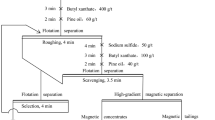Abstract
Successful recovery of limonite from iron fines was achieved by using flocculation-high intensity magnetic separation (FIMS) and adding hydrolyzed and causticized flocculants according to the characteristic of iron fines. The separation results of the three iron samples are as follows: iron grade 66.77%–67.98% and the recovery of iron 69.26%–70.70% by the FIMS process with flocculants. The comparative results show that under the same separation conditions the FIMS process can effectively increase the recovery of iron by 10.97%–15.73%. The flowsheet results confirm the reliability of the process in a SHP high intensity magnetic separator. The concentrate product can be used as raw materials for direct reduction iron-smelting. The hydrolyzed and causticized flocculants can selectively flocculate fine feebly-magnetic iron mineral particles to increase their apparent separation sizes. The larger the separation size, the stronger the magnetic force. By comparing the separation results of the three samples it is found that among the three samples the higher the limonite content, the better the separation result. This means that the separation result relates closely to the flocculation process and the adding pattern of the flocculant.
Similar content being viewed by others
References
Arol A I, Aydogan A. Recovery enhancement of magnetite fines in magnetic separation [J]. Colloids and Surfaces A: Physicochemical and Engineering Aspects, 2004, 232(2–3): 151–154.
Nakajima H, Kaneko H, Oizumi M, et al. Separation characteristics of open gradient magnetic separation using high-temperature superconducting magnet [J]. Physica C: Superconductivity, 2003, 392–396 (Part 2): 1214–1218.
LUO Li-qun, ZHANG Jing-sheng, YU Yong-fu, et al. Applied research on film-magnetic separation technique [J]. Mining and Metallurgical Engineering, 2004, 24(4): 22–26. (in Chinese)
Karapinar N. Magnetic separation of ferrihydrite from wastewater by magnetic seeding and high-gradient magnetic separation[J]. International Journal of Mineral Processing, 2003, 71(1–4): 45–54.
Shao Y, Veasey T J, Rowson N A. Wet high intensity magnetic separation of iron minerals[J]. Magnetic and Electrical Separation, 1996, 8(1): 41–51.
Wasmuth H D, Unkelbath K H. Recent developments in magnetic separation of feebly magnetic minerals[J]. Minerals Engineering, 1991, 4(7–11): 825–837.
LIU Qi, ZHANG Ya-hui, Laskowski J S. The adsorption of polysaccharides onto mineral surface: an acid/base interaction[J]. International Journal of Mineral Processing, 2000, 60(3–4): 229–245.
Wang Y M, Rorssberg E. Recent activities in magnetic Sweden [J]. Magnetic and Electrical Separation, 1995, 7(1): 1–18.
Hatch G P, Stelter R E. Magnetic design considerations for devices and particles used for biological high-gradient magnetic separation (HGMS) systems[J]. Journal of Magnetism and Magnetic Materials, 2001, 225(1–2): 262–276.
Watson J H P. Status of superconducting magnetic separation in the mineral industry[J]. Minerals Engineering, 1994, 7(5–6): 737–746.
Ahamad M O, Shaikh H, Dixit S G. Role of magnetite and sodium oleate in high gradient magnetic separation of calcite using magnetic coating of the surface [J]. Journal Colloid and Interface Science, 1993, 155(2): 340–346.
Parsonage P. Principles of mineral separation by selective magnetic coating[J]. International Journal of Mineral Processing, 1988, 24(3–4): 269–293.
Song S, Lu S, Lopez-Valdivieso A. Magnetic separation of hematite and limonite fines as hydrophobic flocs from iron ores[J]. Minerals Engineering, 2002, 15(6): 415–422.
Prakash S, Das B, Mohanty J K, et al. The recovery fine minerals from quartz and corundum mixtures using selective magnetic coating [J]. International Journal of Mineral Processing, 1999, 57(2): 87–103.
Bhagat R P, Pathak P N. The effect of polymeric dispersant on magnetic separation of tungsten ore slimes[J]. International Journal of Mineral Processing, 1996, 47(3–4): 213–217.
Author information
Authors and Affiliations
Corresponding author
Additional information
Foundation item: Chinese-Australia Government Cooperate Item
Rights and permissions
About this article
Cite this article
Luo, Lq., Zhang, Js. & Yu, Yf. Recovering limonite from Australia iron ores by flocculation-high intensity magnetic separation. J Cent. South Univ. Technol. 12, 682–687 (2005). https://doi.org/10.1007/s11771-005-0069-y
Received:
Accepted:
Published:
Issue Date:
DOI: https://doi.org/10.1007/s11771-005-0069-y




